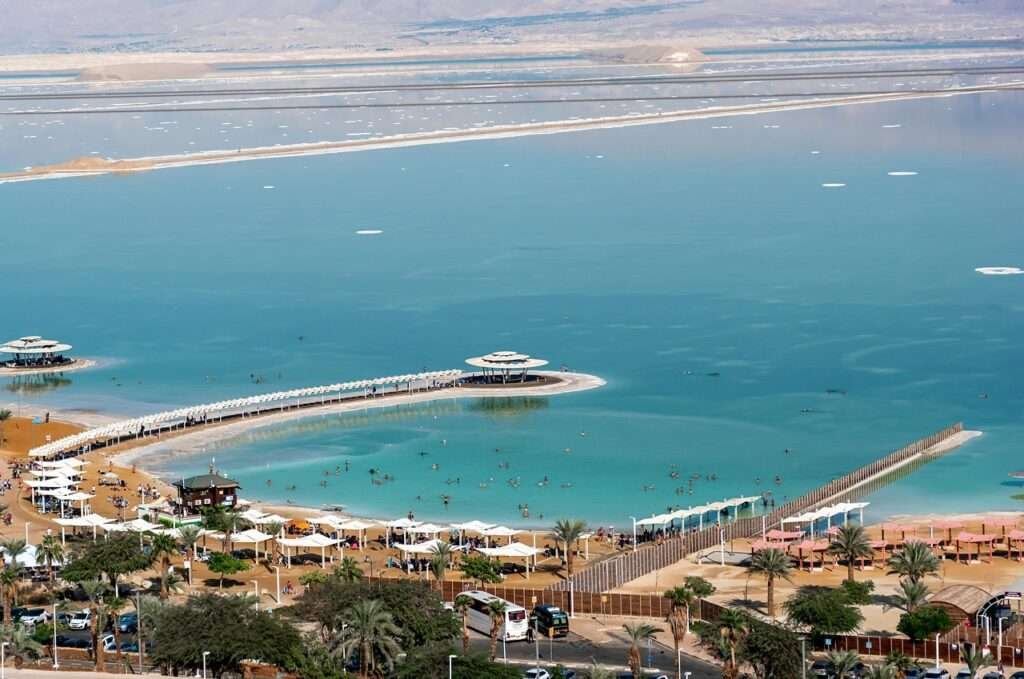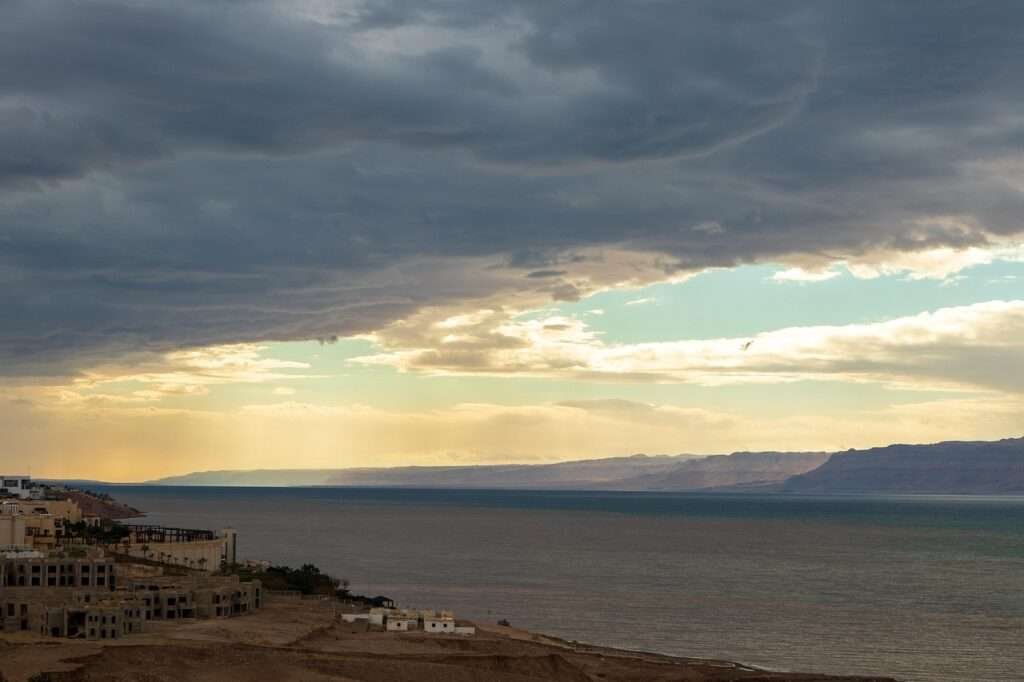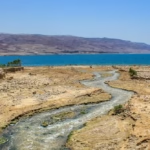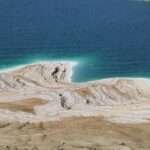It’s a practical comparison of visiting the Dead Sea from the Israeli/West Bank shore versus the Jordanian shore. In short: Israel offers the biggest resort zone and blockbuster sites like Masada, while Jordan offers quieter coastline, canyon adventures (Wadi Mujib), and cost savings with the Jordan Pass—so the “better” side depends on your plan and passport.
Quick Primer: Where the Dead Sea Sits & Why It’s Split
The Dead Sea is a hypersaline lake in the Jordan Rift Valley, bordered by Jordan to the east and Israel/West Bank to the west. It’s the planet’s lowest exposed land, around 1,300 feet (≈430 meters) below sea level; evaporation makes the water so salty (≈10× ocean) that you float without trying. This extreme setting is widely documented by reference works and meteorological agencies.
Visitors mostly encounter two areas. The northern basin is the natural lake with rapidly receding shores; the southern “basin” is a grid of industrial evaporation ponds near Ein Bokek that also front the main resort beaches. Understanding this split explains why sinkholes affect some northern sites while Ein Bokek’s beaches remain stable and resort-friendly.
North vs. South Basins (what visitors actually see)
North = wild views and heritage sites (Qasr al-Yahud; Al-Maghtas across the river), plus closures around certain beaches due to sinkholes. South = the purpose-built hotel strip at Ein Bokek with promenades, lifeguards, and easy water access for day trippers and spa-seekers.
| Metric | North Basin (natural) | South Basin (resort zone) |
|---|---|---|
| Feel | Wild, receding shoreline, heritage nearby | Built-up hotels, engineered shoreline |
| Common Issues | Sinkholes & intermittent closures | Stable beaches, easy access |
| Iconic Stops | Qasr al-Yahud; Al-Maghtas | Ein Bokek promenade; spa hotels |
Snapshot Answer — Which Side Fits Which Traveler?
If you want the greatest concentration of resort hotels, lifeguarded public beaches, and fast access to a UNESCO fortress (Masada), the Israeli side is the simple pick. Ein Bokek’s beachfront is purpose-designed with shade, showers, changing rooms, and accessible water entries—excellent for families and spa-days.
If you crave slot-canyon fun, quieter coastline, sweeping panoramas, and a money-saving pass that can waive your visa fee, the Jordanian side is compelling. Wadi Mujib’s seasonal wet trails (usually April–October) add genuine adventure, while the official Jordan Pass bundles visa waiver (with a minimum stay) plus >40 sites including Petra.
Israel side at a glance

Expect a polished resort experience in Ein Bokek, easy day trips to Masada, and the option to visit the Jordan River baptism site at Qasr al-Yahud. The beach infrastructure is free to use and well-maintained; the Masada cableway whisks you to a world-class UNESCO site with sunrise views over the Moab mountains.
Jordan side at a glance

You’ll base around Sweimeh (≈34 miles / 55 kilometers from Amman). Resorts front the water, the Dead Sea Panorama Complex crowns the cliffs, and Wadi Mujib’s “wet” canyons run in warm months. The UNESCO-listed Baptism Site “Bethany Beyond the Jordan” (Al-Maghtas) sits just north of the Dead Sea.
Getting There, Borders & Practicalities
For Israel, most travelers fly into Ben Gurion Airport (TLV) near Tel Aviv and drive roughly 60–100 miles (≈100–165 kilometers) depending on the beach or site. For Jordan, Queen Alia International (AMM) near Amman is about 34 miles (≈55 kilometers) from Sweimeh’s hotel strip. Driving times vary with security and roadworks; plan buffer time in summer heat.
Border note (2025): The Allenby/King Hussein Bridge has unique visa rules and has also seen intermittent closures for security reasons. Critically, visas are not issued on arrival at this crossing for many nationals (including U.S. citizens); arrive with a Jordanian visa or use other entry points (e.g., QAIA, Sheikh Hussein/Jordan River, or Wadi Araba/Aqaba). Always check official updates before travel.
Airports and drive times
Typical routes: TLV → Route 1/90 for Jerusalem–Ein Gedi–Ein Bokek; AMM → Airport Highway → Dead Sea Highway to Sweimeh. Distances: Jerusalem to Ein Bokek ≈62 miles (≈100 kilometers); Tel Aviv to Ein Bokek ≈103 miles (≈165 kilometers); Amman to Sweimeh ≈34 miles (≈55 kilometers). These are approximations; road closures (e.g., flash-flood damage or sinkholes) can add time.
Visas, the Jordan Pass & border crossings
The official Jordan Pass costs 70/75/80 JOD (Wanderer/Explorer/Expert) and can waive the tourist visa fee if you purchase it before arrival and stay the required minimum nights (listed by the program). Entry is straightforward at QAIA and most land borders—but not at Allenby/King Hussein Bridge for many nationalities, which does not issue visas on arrival.
For Israel, entry policies vary by nationality and security context; consult your foreign ministry’s guidance and Israel’s official advisories before you go. If you plan to cross between countries, verify exit taxes, opening hours, and any closures within 24–48 hours of travel.
Beaches, Facilities & Iconic Sights (What You’ll Do)
Israel — resort ease & headline heritage. Ein Bokek is the principal beach zone with a long, shaded promenade, showers, changing rooms, lifeguards, and fully accessible entries into the water—excellent for first-timers and families. From here it’s a quick hop to Masada National Park (UNESCO), where the cable car rises from below sea level to an ancient desert fortress. For religious heritage, Qasr al-Yahud on the Jordan River is open for baptisms and visits.
Jordan — canyon thrills & pilgrimage on the east bank. The Mujib Biosphere Reserve, the world’s lowest nature reserve, offers seasonal “wet” trails that have you wading and scrambling through a sandstone slot to waterfalls—an unforgettable half-day in warm months (usually April–October). North of the Dead Sea, the UNESCO-listed Baptism Site “Bethany Beyond the Jordan” (Al-Maghtas) anchors Christian pilgrimage on the east bank.
Israel: Ein Bokek, Masada & Qasr al-Yahud
Ein Bokek’s infrastructure (shaded seating, accessible platforms, showers) is deliberate: it solves the challenges of heat and the briny water. Masada’s UNESCO inscription explains its universal value; sunrise or late-day visits beat the heat. Qasr al-Yahud sits opposite Jordan’s Al-Maghtas, making it easy to appreciate the shared heritage from both shores on a single trip (with proper visas). Masada UNESCO listing · Masada National Park (official) · Qasr al-Yahud (official).
Jordan: Sweimeh resorts, Wadi Mujib & Al-Maghtas
Resorts cluster at Sweimeh with day passes for mud baths and float time. The Mujib Biosphere Reserve (lowest on Earth) adds adventure in season; off-season, visit the UNESCO World Heritage baptism site and the cliff-edge Panorama Complex. Consider the Jordan Pass if Jordan is your main destination (savings compound if you also visit Petra, Jerash, and Wadi Rum).
Environmental caveats: sinkholes & safety
Rapid shoreline retreat has created hazardous sinkholes in parts of the north; several long-familiar Israeli public beaches around Ein Gedi remain closed. Always obey signage and choose managed beaches with lifeguards and freshwater showers to rinse off the brine.
| Comparison Metric (2025) | Israel Shore (Ein Bokek area) | Jordan Shore (Sweimeh/Wadi Mujib) |
|---|---|---|
| Nearest major airport | Ben Gurion (TLV) | Queen Alia (AMM) |
| Typical drive to coast | ~103 miles (≈165 km) from Tel Aviv; ~62 miles (≈100 km) from Jerusalem | ~34 miles (≈55 km) from Amman |
| Signature experiences | Ein Bokek free public beach; Masada cableway; Qasr al-Yahud | Wadi Mujib wet canyon (seasonal); Al-Maghtas UNESCO; Panorama Complex |
| Beach facilities | Promenade, shade, showers, accessible decks, lifeguards | Hotel day-passes; limited public access points |
| Visa/entry saver | N/A (check your nationality’s rules) | Jordan Pass (70/75/80 JOD; visa fee waived with minimum stay) |
| Seasonal caution | Extreme heat May–Sep; some northern beaches closed due to sinkholes | Wadi Mujib trails usually Apr–Oct only; extreme heat in midsummer |
When to Go, Weather & Safety Basics
For heat-sensitive travelers, March–May and October–November are sweet spots. Summer air can exceed 115°F (46°C), and Israel’s Sdom station has recorded extreme spikes near 122°F (≈50°C) in past years; plan dawn or late-afternoon outdoor time, carry 2–3 liters of water per person, and protect electronics from salt.
Always float on your back; don’t dunk your head; keep fresh water for eyes and small cuts. Use only managed beaches or hotel access points and follow lifeguard instructions. In canyons (Jordan), heed seasonal closures and flash-flood warnings—Wadi Mujib’s wet trails typically shut in winter for safety.
Who Should Choose Which Side? (Personas & sample itineraries)
Wellness weekender (spa & float): Pick Israel’s Ein Bokek. Stay beach-side, float before breakfast, visit Masada at sunset, and add a short hike in Ein Gedi Nature Reserve (trail openings vary).
Adventure & heritage combo: Choose Jordan. Float at a resort, run the Wadi Mujib Siq Trail on a warm-season morning, then visit Al-Maghtas for a UNESCO pilgrimage perspective, adding Mount Nebo or Madaba mosaics the next day.
Two-country sampler: If you have a week and the right visas, do both: start in Jerusalem → Masada/Ein Bokek (2–3 days) → cross via Sheikh Hussein or Wadi Araba → Amman/Sweimeh & Wadi Mujib (2–3 days). Avoid Allenby unless your visa situation is crystal-clear and the terminal is confirmed open.
FAQ
Is the Dead Sea safe to swim in on both sides?
Yes—when you use managed beaches with lifeguards and freshwater showers. Avoid unsupervised spots, heed signage about sinkholes, and never dive or submerge your head in the brine.
When does Wadi Mujib open for the “wet” canyon hikes?
In most years the wet trails run roughly April–October, closing in winter due to flood risk. Always confirm opening status with RSCN/Visit Jordan the week you go.
Can I get a Jordan visa on arrival at the Allenby/King Hussein Bridge?
For many nationalities (including U.S.), no—VOA is not issued there; arrange a visa in advance or enter via Queen Alia Airport or other land crossings that offer VOA. Rules can change, so verify close to travel.
What Did We Learn Today?
- The Israeli side (Ein Bokek) excels for resort infrastructure, free public beaches, and quick access to Masada (UNESCO) and Qasr al-Yahud.
- The Jordanian side shines for Wadi Mujib’s seasonal slot-canyon hikes and the UNESCO baptism site at Al-Maghtas.
- Allenby/King Hussein Bridge has restrictive visa rules and periodic closures—plan alternate entry points as needed (2025).
- Sinkholes affect parts of the northern shore; stick to managed, lifeguarded beaches.
- Best months: spring and autumn; summers can top 115°F (46°C) at the basin’s low elevation.





